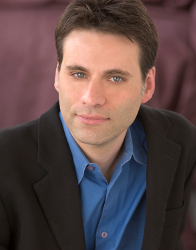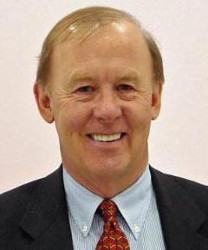Posted by Elena del Valle on February 26, 2018

Frank Ford, co-author, Happy Accidents
Photo: Courtesy of Four Day Weekend
A podcast interview with Frank Ford, co-author, Happy Accidents the Transformative Power of “Yes, and” at work and in Life, is available in the Podcast Section of Hispanic Marketing & Public Relations, HispanicMPR.com. During the podcast, he discusses the transformative power of improv with Elena del Valle, host of the HispanicMPR.com podcast.
Frank has had a successful career in the entertainment industry for the last 25 years and is one of the founding members and owner of Four Day Weekend, a Texas comedy company. He has also studied at the Second City Conservatory in Chicago and taught advanced improvisation classes at the Four Day Weekend Training Center.
Frank has appeared in numerous commercial spots, television shows and films. In addition, he has been recognized for his original comedy revues, comedy album, short films and acting roles. In addition to performing in over 5,000 shows and working with Fortune 500 companies throughout the world, Frank is a keynote presenter on the speaker circuit.
To listen to the interview, scroll down until you see “Podcast Frank Ford” on the right hand side, then select “HMPR ” and click on the play button below or download the MP3 file to your iPod or MP3 player to listen on the go, in your car or at home from the RSS feed. Some software will not allow flash, which may be necessary for the play button and podcast player. If that is your case, you will need to download the file to play it. To download it, click on the arrow of the recording you wish to copy and save it to disk. The podcast will remain listed in the February 2018 section of the podcast archive.

Click to buy Happy Accidents
Posted by Elena del Valle on February 20, 2018

Alex Parkinson, associate director, Society for New Communications Research
Photo: Jaycee Crawford
A podcast interview with Alex Parkinson, associate director, Society for New Communications Research is available in the Podcast Section of Hispanic Marketing & Public Relations, HispanicMPR.com. During the podcast, he discusses the Society with Elena del Valle, host of the HispanicMPR.com podcast.
Alex is also senior researcher at the Society for New Communications Research of The Conference Board (SNCR). He specializes in corporate philanthropy, and communications and marketing, and is the executive editor of the Giving Thoughts and SNCR blogs and accompanying online publications.
Alex led the integration effort between the Society for New Communications Research (SNCR) and The Conference Board when the two organizations came together in February 2016. He is a member of the SNCR Advisory Board.
Before joining The Conference Board in September 2013, he worked as a senior consultant in London and New York for Context. At the time he advised his clients Bloomberg, Brown-Forman, BSkyB, Burt’s Bees, Cisco, HP, International Paper, PepsiCo, Roche, Standard Chartered, Syngenta, Teva Pharmaceuticals, and Vodafone corporate social responsibility communications and strategy development.
To listen to the interview, scroll down until you see “Podcast Alex Parkinson” on the right hand side, then select “HMPR ” and click on the play button below or download the MP3 file to your iPod or MP3 player to listen on the go, in your car or at home from the RSS feed. Some software will not allow flash, which may be necessary for the play button and podcast player. If that is your case, you will need to download the file to play it. To download it, click on the arrow of the recording you wish to copy and save it to disk. The podcast will remain listed in the February 2018 section of the podcast archive.
Posted by Elena del Valle on February 15, 2018
Jill Filipovic, a contributing opinion writer for The New York Times, believes women want the freedom to pursue happiness without gender, class, location and identity biases and constraints. In The H-Spot The Feminist Pursuit of Happiness (Hachette Audio, $30) she discusses her experiences, her research and the impressions she formed from conversations with some women and men from various parts of the country.
In the audiobook, narrated by the author, she explores the history of working women in the United States and her concerns about the pervasive inequality that plagues our country. She outlines the burden presented by high standards of feminine perfection for women and the requirement that they be willing to sacrifice their happiness and well being for their loved ones, while she acknowledges that some of the standards are perpetuated by women. She highlights that the requirements for being a “good mother” have never been so extreme. The author points out the need for political and social changes at the national level.
Multiple requests over several weeks to respond to book related questions and for a book image via her website, Twitter and her publisher were unanswered. According to a biography for Filipovic on her publisher’s website she is a regular columnist for Cosmopolitan.com, where she was previously a senior political writer. A former columnist for the Guardian, she is also an attorney. The biography also indicates that her work on law, politics, gender and foreign affairs has appeared in The Washington Post, Time, Nation, and Foreign Policy.
Click to buy The H-Spot
Comments:
Filed Under: Books
Posted by Elena del Valle on February 6, 2018
By Jay Gronlund
President, The Pathfinder Group

Jay Gronlund, president, The Pathfinder Group
Photo: Jay Gronlund
Most people think “branding” is simply about creating a catchy, memorable name for a product, service, organization and even people. However branding is much more complex. Good branding starts with the development of a message or impression that reflects the unique benefits and characteristics of that entity, and then creating a name that ideally communicates its qualities and personality to targeted customers. There are numerous approaches and philosophies for brand naming. Here are two contrasting examples: President Donald Trump’s tendency to coin descriptive, simplistic (and usually negative) labels on his adversaries that reflect his opinion of them, and the more subconscious, subliminal use of “phonologics” by pharmaceutical companies to create brand names for their products.
Click to read the entire article Brand Naming, The Unsubtle (Trump) And The Subtle (Pharmaceuticals)
Posted by Elena del Valle on January 29, 2018

Eddie Yoon, founder, Eddiewouldgrow, LLC
Photo: Eddie Yoon
A podcast interview with Eddie Yoon, founder, Eddiewouldgrow is available in the Podcast Section of Hispanic Marketing & Public Relations, HispanicMPR.com. During the podcast, he discusses Superconsumers with Elena del Valle, host of the HispanicMPR.com podcast.
Eddie is author of Superconsumers A Simple, Speedy and Sustainable Path to Superior Growth. Prior to founding Eddiewouldgrow, LLC, a think tank and advisory firm on growth, he was a partner at The Cambridge Group. According to his biography, his work over the past two decades has driven over $5 billion of annual profitable growth in consumer packaged goods, durables, robotics and energy; and he is one of the world’s leading experts on finding and monetizing superconsumers to grow and even create new categories.
To listen to the interview, scroll down until you see “Podcast Eddie Yoon” on the right hand side, then select “HMPR ” and click on the play button below or download the MP3 file to your iPod or MP3 player to listen on the go, in your car or at home from the RSS feed. Some software will not allow flash, which may be necessary for the play button and podcast player. If that is your case, you will need to download the file to play it. To download it, click on the arrow of the recording you wish to copy and save it to disk. The podcast will remain listed in the January 2018 section of the podcast archive.
Posted by Elena del Valle on January 22, 2018

Danielle Gruppo, CEO, InternAlliance
Photo: Sharon K. Merkel
A podcast interview with Danielle Gruppo, chief executive officer, InternAlliance is available in the Podcast Section of Hispanic Marketing & Public Relations, HispanicMPR.com. During the podcast, she discusses the business of internships with Elena del Valle, host of the HispanicMPR.com podcast.
Danielle is also the founder of InternAlliance, an online service that connects qualified college students to viable internship opportunities. She has 25 years of experiences as a human resources executive developing and executing talent management and human capital strategies for Fortune 250 and privately held companies in energy, healthcare, services, and manufacturing.
She is a results-oriented achiever dedicated to building programs that foster a corporate culture of employee engagement, inclusion, and compliance by employing keen business acumen and demonstrating key expertise.
To listen to the interview, click on the play button below, scroll down until you see “Podcast” on the right hand side, then select “HMPR Danielle Gruppo” and click on the play button below or download the MP3 file to your iPod or MP3 player to listen on the go, in your car or at home from the RSS feed. Some software will not allow flash, which may be necessary for the play button and podcast player. If that is your case, you will need to download the file to play it. To download it, click on the arrow of the recording you wish to copy and save it to disk. The podcast will remain listed in the January 2018 section of the podcast archive.
Posted by Elena del Valle on January 15, 2018

Joseph Pizzorno, N.D., author, The Toxin Solution
Photo: Joseph Pizzorno
A podcast interview with author Joseph Pizzorno, N.D. is available in the Podcast Section of Hispanic Marketing & Public Relations, HispanicMPR.com. During the podcast, he discusses The Toxin Solution (see Naturopath discusses hidden toxins in our lives and how to be rid of them) with Elena del Valle, host of the HispanicMPR.com podcast.
He has been an academic, intellectual and clinical leader in functional integrative and natural medicine for four decades. Pizzorno is also editor-in-chief, Integrative Medicine, and A Clinician’s Journal; as well as president, SaluGenecists, Inc., and treasurer, board of directors, Institute for Functional Medicine, and founding president, Bastyr University.
To listen to the interview, scroll down until you see “Podcast Joseph Pizzorno, ND” on the right hand side, then select “HMPR ” and click on the play button below or download the MP3 file to your iPod or MP3 player to listen on the go, in your car or at home from the RSS feed. Some software will not allow flash, which may be necessary for the play button and podcast player. If that is your case, you will need to download the file to play it. To download it, click on the arrow of the recording you wish to copy and save it to disk. The podcast will remain listed in the January 2018 section of the podcast archive.
Posted by Elena del Valle on January 8, 2018

János Mészáros, author, Kings and Crosses
Photo: János Mészáros
A podcast interview with graphic novel author János Mészáros is available in the Podcast Section of Hispanic Marketing & Public Relations, HispanicMPR.com. During the podcast, he discusses Kings and Crosses with Elena del Valle, host of the HispanicMPR.com podcast.
János, who writes under the pen name Sinonimo, is owner of Libub Group Kereskedelmi És Zolgátató Kft. He spent over 20 years in management consultancy in Hungary and across Europe. Kings and Crosses is his first fiction work. He created the story and the story board for the graphic novel.
To listen to the interview, scroll down until you see “Podcast János Mészáros” on the right hand side, then select “HMPR ” and click on the play button below or download the MP3 file to your iPod or MP3 player to listen on the go, in your car or at home from the RSS feed. Some software will not allow flash, which may be necessary for the play button and podcast player. If that is your case, you will need to download the file to play it. To download it, click on the arrow of the recording you wish to copy and save it to disk. The podcast will remain listed in the January 2018 section of the podcast archive.
Posted by Elena del Valle on January 2, 2018

Wishing you a healthy, joyful and success filled 2018!
Posted by Elena del Valle on December 13, 2017

Lucas Puente, economist, Thumbtack
Photo: Lucas Puente
A podcast interview with Lucas Puente, economist, Thumbtack, is available in the Podcast Section of Hispanic Marketing & Public Relations, HispanicMPR.com. During the podcast, he discusses 2017 Thumbtack Small Business Friendliness Survey with Elena del Valle, host of the HispanicMPR.com podcast.
Lucas studies Thumbtack’s marketplace dynamics and the policy challenges facing small service businesses. Passionate about using data to better understand the American economy, Lucas’ previous research topics include decision making at the Federal Reserve and the role of technology in the contemporary labor market. He has a master’s degree and Ph.D. from Stanford University and is a graduate of the University of Georgia.
To listen to the interview, scroll down until you see “Podcast” on the right hand side, then select “HMPR Lucas Puente” and click on the play button below or download the MP3 file to your iPod or MP3 player to listen on the go, in your car or at home from the RSS feed. Some software will not allow flash, which may be necessary for the play button and podcast player. If that is your case, you will need to download the file to play it. To download it, click on the arrow of the recording you wish to copy and save it to disk. The podcast will remain listed in the December 2017 section of the podcast archive.



















